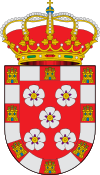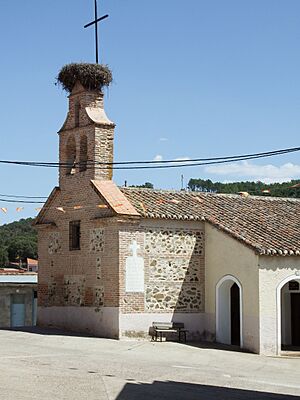Anchuras facts for kids
Quick facts for kids
Anchuras
|
||
|---|---|---|

Ciudad Real Province with the enclave of Anchuras on the west
|
||
|
||
| Country | ||
| Autonomous community | Castile-La Mancha | |
| Province | Ciudad Real | |
| Comarca | La Jara | |
| Area | ||
| • Total | 231.05 km2 (89.21 sq mi) | |
| Elevation | 560 m (1,840 ft) | |
| Population
(2018)
|
||
| • Total | 327 | |
| • Density | 1.4153/km2 (3.666/sq mi) | |
| Demonym(s) | Anchureño/a | |
| Time zone | UTC+1 (CET) | |
| • Summer (DST) | UTC+2 (CEST) | |
| Postal code |
13117
|
|
Anchuras (also known as Rincón de Anchuras) is a small town in Ciudad Real Province, Spain. It is part of the Castile-La Mancha region. In 2018, about 327 people lived there.
Anchuras is special because it is an enclave. This means it is a piece of land that belongs to one area but is completely surrounded by other areas. Anchuras is surrounded by Toledo Province and Badajoz Province. It is located in the Montes de Toledo mountains.
Contents
History of Anchuras
Anchuras is now known as "Anchuras de los Montes." This is because it is part of the Los Montes region in Ciudad Real. But it wasn't always called that. Before, it was known as "Anchuras de la Jara." This name came from the southern lands of the La Jara region. These lands were managed by Talavera de la Reina until the 1500s.
Early Settlements and Growth
For a long time, this area was covered in forests. We don't have records of people living here until the 1300s. The first people to settle here were beekeepers. They also grew small fields of rye and raised pigs to survive.
Slowly, more people moved into the area. By the 1400s, a small group of huts formed a hamlet. This first settlement was called La Nava de los Enjambres. By the late 1500s, it had about twenty huts and a small church called a hermitage.
The main town of Anchuras itself appeared in the mid-1600s. The first houses were built on a hill called Pastuero. A small church was also built there. It was a simple building with one room and a wooden roof. This church was built to house a statue of the Virgen del Gamonal. This statue had been in a hermitage about 2 kilometers away.
In 1676, the Archbishop of Toledo, Pascual Aragón, made the church a parish. He named it after Nuestra Señora de la Asunción. Anchuras then became the most important place for religion, trade, and travel in the area. It grew bigger than the older settlement of Enjambre.
New Hamlets and Modern Times
In the early 1700s, another hamlet called Encinacaída started to form. It was about 2.5 kilometers from Anchuras. Its houses were made of slate and covered with broom and mud. The hamlet got its name from an oak tree that was bent by the wind but didn't fall.
Around 1879, some people from Aldeanueva de San Bartolomé bought land called Gamonoso. They built their houses on a hill and divided the land. This new hamlet was named Gamonoso after the land.
Finally, in the late 1800s, a new hamlet called Las Huertas del Sauceral was created. It was in a hollow and got its name from small gardens and willow trees.
Anchuras became well-known because the government wanted to build a training camp for the Air Force there. This was a place for target practice. A similar camp had not been built in Cabañeros. In 1988, Anchuras was declared a "Zone of Interest for the Defense." However, many people protested against this plan. Environmental groups, peace groups, and local residents joined together. Their protests worked, and in 1996, the government canceled the plan.
Villages
Anchuras is the main town, but there are also several smaller villages nearby:
- Anchuras (the main town)
- Encinacaída
- Enjambre
- Las Huertas
- Gamonoso
See also
 In Spanish: Anchuras para niños
In Spanish: Anchuras para niños




